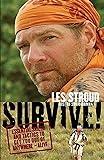Hey, outdoor enthusiasts! Today we are going to guide you through an essential skill that could save your life during your next wilderness adventure. Every time we go outdoors there is a chance that we can get turned around and find ourselves lost. This can even happen in familiar areas, especially in the dark or poor weather. By following the S.T.O.P (Stop, Think, Observe, Plan) method you will be able to handle whatever situation you find yourself in.
Have you heard of the S.T.O.P method? It’s a simple, yet powerful tool to keep you safe and sound when you’re out exploring Mother Nature. It’s often taught in hunters’ safety classes, but we believe that everyone who goes outdoors should know it. Whether you’re hiking, camping, or just enjoying a day in the woods, S.T.O.P will help you handle unexpected situations. Let’s dive in!
Key Takeaways:
- S.T.O.P stands for: Stop, Think, Observe, Plan.
- It’s a method to help you stay calm and make smart decisions in the wild.
- Each step is crucial for ensuring your safety and well-being.
- This method is easy to remember and effective in various outdoor scenarios.
- Always pack a hiking first aid kit and the 10 essentials, even for short hikes.

1. Stop
When you realize you’re in an uncertain or tricky situation, the first thing to do is STOP. This means physically stopping your movement and calming your mind. Panic is your biggest enemy in survival situations. Sit down if possible, take deep breaths, and resist the urge to make hasty decisions (1).
- Take deep breaths to calm yourself.
- Sit or stand still to conserve energy.
- Avoid making any rash moves until you have a clearer picture of your situation.
2. Think
Now, it’s time to THINK. Assess your situation. What do you know about your location? How much daylight is left? Check your resources – do you have water, food, shelter materials? Thinking through these factors will help you avoid making decisions based on fear or stress.
- Evaluate your basic needs: How much water and food do you have?
- Think about your safety: Are you in a safe spot, or do you need to move to a more secure location?
- Consider your time: How much daylight do you have left?
- Use logic over emotion: Focus on factual information rather than letting fear take over.
3. Observe
Next up, OBSERVE your surroundings. Are you near a water source? Can you identify any landmarks that you recognize from your map? Pay attention to the weather and your environment. Observing helps you get a clearer picture of your situation and how you can use it to your advantage.
- Look for natural resources: Is there a water source nearby? Can you find materials for shelter?
- Identify landmarks: Can you see any distinctive features in the landscape that might help you orient yourself?
- Note the weather conditions: Is a storm approaching? How will the weather impact your next steps?
- Check your gear: Take inventory of what you have with you – every item could be useful.
4. Plan
Finally, it’s time to PLAN. Based on your assessment and observations, make a plan of action. This might be setting up a shelter, signaling for help, or finding a safer location. Your plan should prioritize your immediate safety and basic needs (like water and warmth).
- Set clear, achievable goals: Whether it’s building a shelter or signaling for help.
- Prioritize based on your situation and focus on the Survival Rule of Three.
- Be ready to adapt: If your situation changes, be prepared to revise your plan.
Recommended Video
Recommended Reading

The Ultimate Survival Guide (HarperEssentials) By: Wiseman, John 'Lofty'

Survive!: Essential Skills and Tactics to Get You Out of Anywhere - Alive
Conclusion
The S.T.O.P method isn’t just a survival strategy; it’s a mindset that encourages calm, rational decision-making in the face of adversity. By practicing these steps, you can enhance your outdoor experiences and handle challenges with confidence. Remember, the wilderness is unpredictable, but with the right tools and knowledge, you can navigate it safely. Here’s to your next adventure – may it be safe, exciting, and full of learning!
Reference List
- Wiseman, John. [The Ultimate Survival Guide (HarperEssentials)] [By: Wiseman, John ‘Lofty’] [October, 2004]. HarperTorch, 2004, www.amazon.com/Ultimate-Survival-Guide-HarperEssentials-Wiseman/dp/B00JWD0W36.
